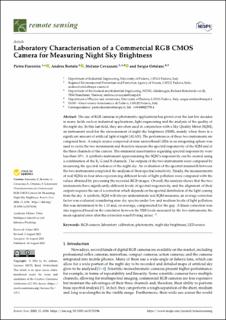| dc.contributor.author | Fiorentin, Pietro | |
| dc.contributor.author | Bertolo, Andrea | |
| dc.contributor.author | Cavazzani, Stefano | |
| dc.contributor.author | Ortolani, Sergio | |
| dc.date.accessioned | 2024-02-01T08:41:45Z | |
| dc.date.available | 2024-02-01T08:41:45Z | |
| dc.date.created | 2023-10-04T12:51:56Z | |
| dc.date.issued | 2023 | |
| dc.identifier.citation | Remote Sensing. 2023, 15 (17), . | en_US |
| dc.identifier.issn | 2072-4292 | |
| dc.identifier.uri | https://hdl.handle.net/11250/3114987 | |
| dc.description.abstract | The use of RGB cameras in photometric applications has grown over the last few decades in many fields such as industrial applications, light engineering and the analysis of the quality of the night sky. In this last field, they are often used in conjunction with a Sky Quality Meter (SQM), an instrument used for the measurement of night sky brightness (NSB), mainly when there is a significant amount of artificial light at night (ALAN). The performances of these two instruments are compared here. A simple source composed of nine narrowband LEDs in an integrating sphere was used to excite the two instruments and therefore measure the spectral responsivity of the SQM and of the three channels of the camera. The estimated uncertainties regarding spectral responsivity were less than 10%. A synthetic instrument approximating the SQM’s responsivity can be created using a combination of the R, G and B channels. The outputs of the two instruments were compared by measuring the spectral radiance of the night sky. An evaluation of the spectral mismatch between the two instruments completed the analysis of their spectral sensitivity. Finally, the measurements of real SQMs in four sites experiencing different levels of light pollution were compared with the values obtained by processing the recorded RGB images. Overall, the analysis shows that the two instruments have significantly different levels of spectral responsivity, and the alignment of their outputs requires the use of a correction which depends on the spectral distribution of the light coming from the sky. A synthetic SQM will always underestimate real SQM measures; an average correction factor was evaluated considering nine sky spectra under low and medium levels of light pollution; this was determined to be 1.11 and, on average, compensated for the gap. A linear correction was also supposed based on the correlation between the NSB levels measured by the two instruments; the mean squared error after the correction was 0.03 mag arcsec−2. | en_US |
| dc.language.iso | eng | en_US |
| dc.publisher | MDPI | en_US |
| dc.rights | Navngivelse 4.0 Internasjonal | * |
| dc.rights.uri | http://creativecommons.org/licenses/by/4.0/deed.no | * |
| dc.title | Laboratory Characterisation of a Commercial RGB CMOS Camera for Measuring Night Sky Brightness | en_US |
| dc.title.alternative | Laboratory Characterisation of a Commercial RGB CMOS Camera for Measuring Night Sky Brightness | en_US |
| dc.type | Peer reviewed | en_US |
| dc.type | Journal article | en_US |
| dc.description.version | publishedVersion | en_US |
| dc.source.pagenumber | 0 | en_US |
| dc.source.volume | 15 | en_US |
| dc.source.journal | Remote Sensing | en_US |
| dc.source.issue | 17 | en_US |
| dc.identifier.doi | 10.3390/rs15174196 | |
| dc.identifier.cristin | 2181626 | |
| cristin.ispublished | true | |
| cristin.fulltext | original | |
| cristin.qualitycode | 1 | |

